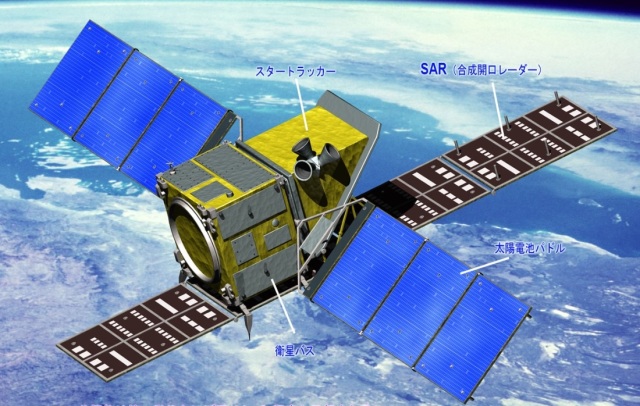As reported by the French bulletin "Intelligence Online" in the article "Japan's imagery shortfall undermines monitoring of Russia-China action around Kuril Islands" ("The shortage of species intelligence data in Japan complicates the monitoring of Russia and China's actions in the Kuril Islands"), the current disunity of the intelligence services of Japan, which have the capabilities of remote sensing of the Earth (remote sensing), prevents the government from achieving its goals within the framework of close monitoring of the movements of Russia and China in the area of the Kuril Islands and in the waters of the China Sea. The possibilities of attracting the private sector are still viewed as questionable.

Image of the Japanese radar reconnaissance satellite of the IGS-Radar series (c) S. Matsuura
A closed group of diplomats and intelligence officers of the Ministry of Foreign Affairs of Japan, created to predict Russian-Chinese movements in the Kuril Islands, is still waiting for a budget decision on the issue of obtaining specific space intelligence data. The team, whose existence was previously reported by Intelligence Online, complained from the very beginning about the lack of access to such data, mainly due to the interdepartmental barriers established by the Japanese government in the use of appropriate capabilities. The presence of these interdepartmental barriers became apparent with the beginning of the work of the Group of Four (Quad) satellites (consisting of the United States of America, Australia, Japan and India), when the Tokyo Ministry of Foreign Affairs surprised its partners with an extremely small contribution to the implementation of alliance species exploration projects.
On the one hand, the Office of Intelligence and Research of the Cabinet of the Prime Minister (Cabinet Intelligence and Research Office, CIRO), or Naicho, has its own operational capabilities. The Department expects to launch the IGS-Radar 8 satellite into near-Earth orbit by the end of the year, which will bring the number of operating radar reconnaissance spacecraft to six. However, despite the fact that these IGS satellites are used for national defense purposes, as well as for disaster management and in the interests of industry, other ministries and departments do not have access to their data.
The first images of the grouping of satellites of a private operator
The Ministry of Foreign Affairs could gain access to a larger array of species intelligence data now that the Q-shu Space Pioneers Institute (IQPS), a subsidiary of Kyushu University established in 2005, has started providing images from its private constellation of remote sensing spacecraft since mid-July. This event is also a life-saving chance for Japan's space radar reconnaissance. The launch of the constellation, which will have a total of 36 satellites in its composition, is Japan's first real success in this area.
In 2019 and 2021, IQPC launched two technology demonstrator satellites with a limited duration of operation in orbit, but lost its first two satellites with full functionality, QPS-SAR-3 and QPS-SAR-4, when launched in October 2022. The first images published in July this year, a month after the launch on June 12, are aimed at convincing potential customers that the resolution of images in the X-band has already reached 0.46 m. IQPS intends to benefit from this trial launch as soon as possible and plans to launch its second production satellite this month.
Unreliable space agency
The fact that most of the information portal is presented exclusively in Japanese illustrates that IQPS' priority is primarily to meet national demand and quickly realize the potential demanded by the Ministry of Foreign Affairs, which still has to rely on the satellites of the Japanese space agency JAXA.
The JAXA toolkit seems unreliable. The agency's ALOS-2 satellite, operating in the L-band and capable of monitoring navigation through the signals of the Automatic Identification system (AIS), is nearing the end of its life cycle. This year it was supposed to be replaced by ALOS-4, but the loss of the ALOS-3 optical observation spacecraft paired with it at launch on March 7 casts doubt on the continuity of the group's functioning.
At the moment, Synspective, as a competitor of IQPS in the process of becoming, also seems to be experiencing difficulties. Having secured investments in the amount of more than $ 200 million. The company has made considerable efforts to enter the market with a fully functional offer, but the fact that its last satellite launched (at the end of last year) was called a "working prototype" did not inspire confidence in potential customers. It seems that the transition to real commercial operation will have to be postponed until the launch of the next spacecraft of the grouping, which in its full configuration should include 25 satellites. This means that diplomats will have to wait a little longer for specific space intelligence data.
�
